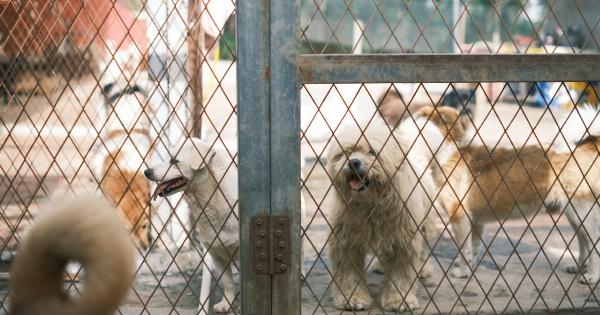When meeting a stunning canine stranger, it’s important to remember that dogs have different comfort levels when it comes to meeting new people. Approaching too quickly can startle them and make them feel anxious or threatened.
Take your time and allow the dog to approach you on their own terms.
Mistake #2: Ignoring the dog’s body language
Dogs communicate primarily through body language, and it’s essential to pay attention to their cues when meeting them for the first time. Signs of discomfort or fear may include tense body posture, raised hackles, or avoidance.
If you notice any of these signals, give the dog some space and allow them to acclimate to the situation.
Mistake #3: Making direct eye contact
While eye contact is often viewed as a sign of trust and engagement in human interactions, for dogs, direct eye contact can be perceived as a threat or challenge. Instead, avert your gaze and allow the dog to approach you at their own pace.
Mistake #4: Reaching out for a pet without permission
Resist the temptation to reach out and pet a stunning canine stranger without first obtaining their owner’s permission. Not all dogs enjoy being touched by unfamiliar individuals, and some may have specific preferences or sensitivities.
Always ask the owner for guidance before making any physical contact with the dog.
Mistake #5: Approaching from behind
Surprising a dog by approaching them from behind can startle them and potentially trigger a defensive response. To avoid this, make sure to approach a dog from the front or side so they can see you approaching.
Mistake #6: Bending over the dog
Bending over a dog can be intimidating and threatening, especially for smaller or more timid dogs. Instead, try crouching down or sitting on the ground to appear less imposing and more approachable.
Mistake #7: Ignoring the leash
Always be aware of the leash when meeting a stunning canine stranger. If the dog is on a leash, it’s important to respect their owner’s boundaries and not approach without permission.
Some dogs may have specific leash reactivity issues, and interfering without knowledge can lead to undesirable outcomes.
Mistake #8: Hovering over the dog
Avoid hovering over a dog, as it can make them feel confined and anxious. Give the dog some space and allow them to move around freely. This will help them feel more comfortable and at ease in your presence.
Mistake #9: Talking loudly or using high-pitched voices
Dogs have sensitive hearing, and talking loudly or using high-pitched voices can startle or overwhelm them. Speak in a calm and soothing tone to help create a positive and relaxed environment during your initial meeting.
Mistake #10: Offering unfamiliar treats
While treats are often used to build positive associations, it’s important to avoid offering unfamiliar treats to a dog you’ve just met.
Some dogs have specific dietary restrictions or allergies, and introducing new treats without proper knowledge can have adverse effects on their health.
Mistake #11: Invading their personal space
Respecting a dog’s personal space is crucial when meeting a stunning canine stranger. Allow the dog to approach you and initiate any contact.
Avoid leaning in too close or crowding their personal bubble, as this can make them feel uncomfortable or threatened.
Mistake #12: Making sudden movements
Sudden movements can startle a dog and potentially trigger fear or aggression. When meeting a stunning canine stranger, it’s best to move slowly and deliberately to avoid alarming them.
This will help create a calm and safe environment for both you and the dog.
Mistake #13: Neglecting proper introductions
When meeting a stunning canine stranger, it’s essential to introduce yourself appropriately. Start by asking the owner for permission to approach or interact with their dog.
This shows respect and consideration, while also ensuring a positive and safe encounter for everyone involved.
Mistake #14: Overwhelming the dog with attention
While you may be excited to meet a stunning canine stranger, bombarding them with excessive attention can be overwhelming. It’s important to give the dog some space and allow them to adjust to your presence at their own pace.
Mistake #15: Making assumptions about their behavior
Every dog is unique, and making assumptions about their behavior based on breed or appearance can be misleading. Avoid stereotypes and take the time to get to know the individual dog and their personality rather than relying on generalizations.
Mistake #16: Punishing unwanted behavior
If a dog exhibits undesirable behavior during your initial meeting, such as barking or jumping, it’s important not to punish them. Remember that they may be anxious or overwhelmed by the new situation.
Instead, redirect their attention to more appropriate behavior and reward them for it.
Mistake #17: Missing signs of fear or anxiety
Dogs can exhibit subtle signs of fear or anxiety that may go unnoticed if you’re not paying close attention. These signs may include panting, lip licking, or tucking their tail between their legs.
Be observant and responsive to their needs, allowing them to feel safe and comfortable.
Mistake #18: Inviting the dog to play without assessing their temperament
While playtime can be enjoyable for both you and a stunning canine stranger, it’s crucial to assess the dog’s temperament before initiating any play.
Some dogs may not be interested in play or could have specific preferences for the type of play they enjoy. Observe their body language and let them guide the interaction.
Mistake #19: Ignoring the dog’s personal boundaries
Respecting a dog’s personal boundaries is vital during the first meeting. If the dog shows signs of discomfort or tries to move away, allow them to do so and give them more space.
Pushing them to engage when they’re not ready can create negative associations and may lead to future behavioral issues.
Mistake #20: Forgetting proper hygiene
Whether it’s your first meeting or a subsequent encounter, always remember proper hygiene practices when interacting with dogs.
Wash your hands before and after any physical contact with a dog to prevent the spread of bacteria or potential allergies.
Mistake #21: Yelling or shouting at the dog
Yelling or shouting at a stunning canine stranger is never an appropriate response, regardless of the situation. Loud or aggressive behavior can escalate the dog’s anxiety or fear and may lead to defensive or aggressive reactions.
Stay calm, quiet, and composed during your interaction.
Mistake #22: Allowing children to approach unsupervised
When children encounter a stunning canine stranger, it’s crucial to supervise their interactions closely. Teach kids how to appropriately approach and pet a dog, and ensure they understand the importance of being gentle and respectful.
Never allow children to approach or interact with a dog unsupervised, as it can pose potential risks.
Mistake #23: Assuming the dog is friendly based on appearance
While a dog may have a stunning and friendly appearance, it’s essential not to assume their temperament without proper observation and assessment.
Some dogs may be anxious, fearful, or reactive, and it’s important to approach each dog with caution and respect.
Mistake #24: Neglecting to ask about sensitivities
Before interacting with a stunning canine stranger, it’s a good practice to ask their owner about any sensitivities or triggers the dog may have. Some dogs may be fearful of certain objects, sounds, or types of touch.
By obtaining this information, you can ensure a more comfortable and safe encounter for everyone involved.
Mistake #25: Dismissing the owner’s instructions
When meeting a dog accompanied by their owner, it’s crucial to listen and follow their instructions. The owner knows their dog best and can provide valuable guidance on how to approach, interact, or handle the dog appropriately.
Mistake #26: Assuming the dog wants to be petted
Remember that not all dogs enjoy being petted or touched by strangers, regardless of their stunning appearance. Always ask the owner for permission before attempting to pet the dog.
Some dogs may prefer verbal interactions, while others might enjoy play or treats as a form of engagement.
Mistake #27: Invading the dog’s space during feeding
Approaching a dog while they’re eating can create unnecessary stress or tension. Dogs can be protective of their food, and interrupting their meal can lead to defensive behavior.
It’s important to give them space and allow them to finish eating in peace.
Mistake #28: Assuming the dog wants to be held or hugged
While some dogs enjoy being held or hugged, it’s important not to assume that all dogs appreciate this type of physical contact. Respect their personal boundaries and preferences when it comes to physical affection.
Look for signs of discomfort and adjust your behavior accordingly.
Mistake #29: Overlooking the dog’s age or health issues
When meeting a stunning canine stranger, it’s crucial to consider their age and potential health issues. Puppies, senior dogs, or dogs with medical conditions may have different needs and limitations.
Be gentle and mindful of these factors during your encounter.
Mistake #30: Rushing the interaction
Last but not least, avoid rushing the interaction with a stunning canine stranger. Building trust and a positive connection takes time. Be patient, allow the dog to set the pace, and respect their comfort levels.
With time and positive experiences, your bond with the dog may grow stronger.






























